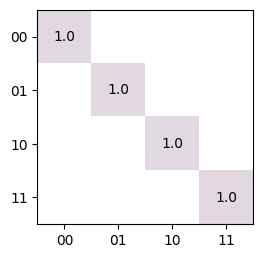Download
Download this file as Jupyter notebook: synthesis.ipynb.
Example: Gate synthesis
This example demonstrates how the built-in compiler can be used to perform gate synthesis.
Synthesizing Single-Qubit Gates
We begin by generating a random gate in \(SU(2)\); we will synthesize this gate later.
[2]:
import trueq as tq
# create a Haar random SU(2) gate and print its matrix representation
U = tq.Gate.random(2)
U
[2]:
- Name:
-
- Gate(Y, X, ...)
- Generators:
-
- 'Y': 86.208
- 'X': 21.93
- 'Z': -160.518
- Matrix:
-
We can perform single qubit gate decomposition into a number of possible “modes”.
Here we decompose the gate U into a ZXZXZ decomposition, which is short hand
for \(Z(\theta)X(90)Z(\phi)X(90)Z(\gamma)\). See
QubitMode for a complete list of all available
single qubit decompositions.
[3]:
synthesized_gate = tq.math.QubitMode.ZXZXZ.decompose(U)
# print the synthesized gate as a list of single-qubit rotations about Z and X
synthesized_gate
[3]:
[('Z', -257.7385690112652),
('X', 90),
('Z', 122.042638725902),
('X', 90),
('Z', -106.283141468562)]
Synthesizing Two-Qubit Gates
In the event that we want to express a two-qubit gate in terms of a different two-qubit gate, we can use the compiler to synthesize the desired gate. Here we decompose a random \(SU(4)\) operation so that it can be implemented using iSWAP gates.
[4]:
# define the gate to be synthesized
gate_to_be_synthesized = tq.Gate.random(4)
# re-express the gate using an iswap gate as the two-qubit gate
two_qubit_synthesized_gate = tq.math.decompose_unitary(
target_gate=gate_to_be_synthesized, given_gate=tq.Gate.iswap
)
# print the synthesized gate
two_qubit_synthesized_gate
[4]:
|
Circuit
|
||
|
|
(0):
Gate(Y, X, ...)
|
(1):
Gate(Y, X, ...)
|
|
|
(0, 1):
Gate.iswap
|
|
|
|
(0):
Gate(Y, X, ...)
|
(1):
Gate(Y, X, ...)
|
|
|
(0, 1):
Gate.iswap
|
|
|
|
(0):
Gate(Y, X, ...)
|
(1):
Gate(Y, X, ...)
|
|
|
(0, 1):
Gate.iswap
|
|
|
|
(0):
Gate(Y, X, ...)
|
(1):
Gate(Y, X, ...)
|
This circuit can be verified to reproduce the original random unitary using an ideal simulator:
[5]:
matrix = tq.Simulator().operator(two_qubit_synthesized_gate).mat()
# This will result in an identity gate up to a global complex phase.
tq.plot_mat(matrix @ gate_to_be_synthesized.adj.mat)

Download
Download this file as Jupyter notebook: synthesis.ipynb.
